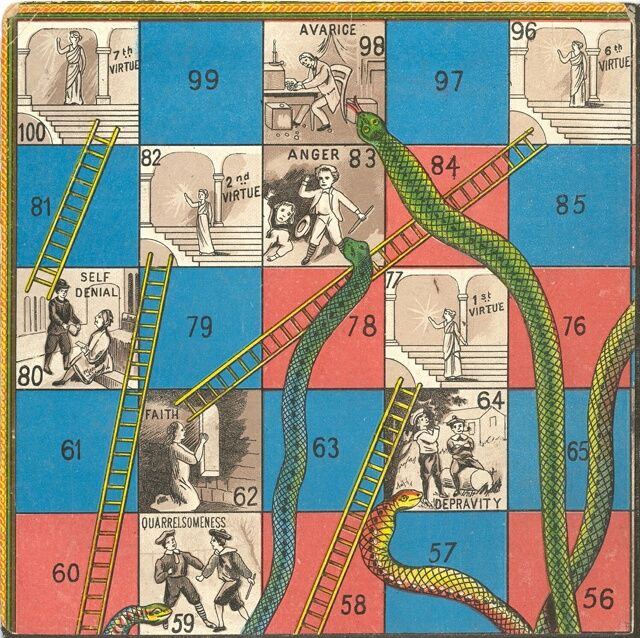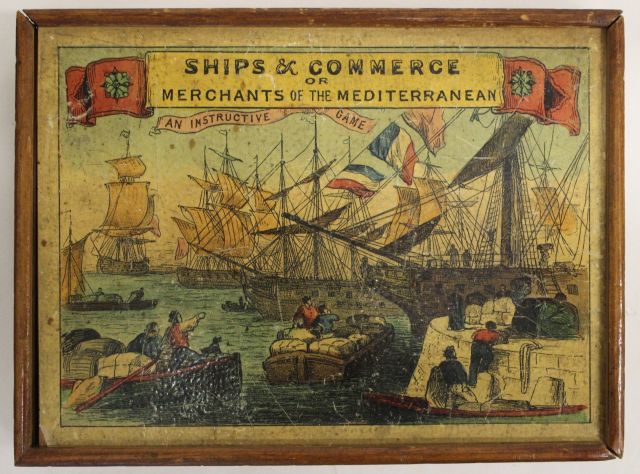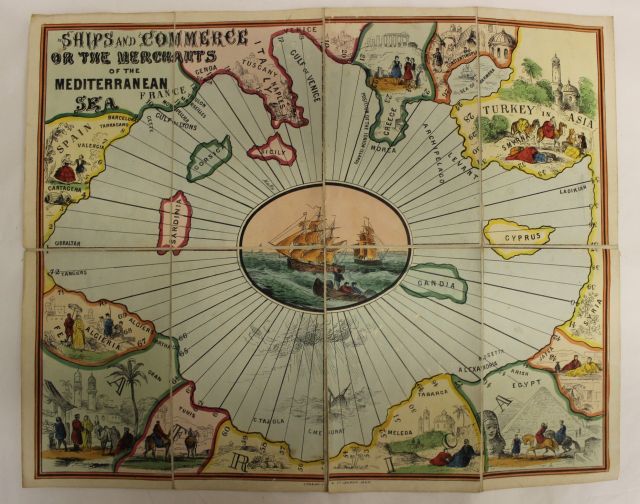By Wayne Kett
Happy New Year!! I suspect many of you like myself enjoyed playing a board game with your family during the Christmas period. In my household this year, it was Monopoly, I usually loose and this year was no different. This got me thinking about the vast array of weird and wonderful board games we have in the toy collection at Strangers’ Hall. So I thought I would share a few of my favorites…..
I begin with a different version of an old classic – Snakes & Ladders.

NWHCM : 1986.31.7 – Kismet, a form of Snakes & Ladders. Published as part of the Globe Series of Games and printed in Bavaria in about 1895

Self denial allows you to jump from square 80 to 100
It follows the same principle as the usual game i.e. snake = bad and ladder = good, but with a twist. Named Kismet, meaning fate or destiny the game was intended to show a child that by being good and obedient, life would be rewarding and generally more pleasant.
Next we have Ships & Commerce or Merchants of the Mediterranean.

NWHCM : 1972.460.9 – Board game, Ships and Commerce or Merchants of the Mediterranean, produced by Standring & Company in the 1860s

The game features a map of the Mediterranean and the countries surrounding it, in the centre is a picture of two sailing ships. It comes with 73 cards each relating to one of the 73 spaces and printed with the name of a product such as wine, marble or tin. As you move around the board (on the roll of a dice) you acquire cards, the winner is the person with the highest value of goods. The intention of the game was educational – to learn which goods or products originated from the different countries and regions.
See the rules in the image below to learn how to play ‘The Ivory Castle Game’
NWHCM : 1986.31.9 – The Ivory Castle Game, produced by DW Gibbs Ltd, 1950s
Finally we have the fantastically named ‘Go-Bang’ game which was produced by the Thomas de la Rue company in the 1870s. It is actually a variation of a Japanese game called Gomoku which roughly translates as five stones. Traditionally the games was played with black and white stones on a grid. The winner was the first person to get five colours in a row, either horizontally or vertically.
NWHCM : 1969.43.27 – Go Bang, published by Thomas de la Rue and Co, 1877
Gomoku was introduced into Britain in the 19th century, but was re-named as ‘Go Bang’ (Connect 4 is also a variation of Gomoku). As you can see from our game the stones have been replaced by red and black counters, but the same principle applies.
There have actually been 7 Gomoku world championships since 1989, the current champion, Zoltan Laszlo of Hungary was crowned in 2017.
Be sure to visit Strangers’ Hall when it opens for the 2019 season on the 20th February.
Follow us on Twitter @NMSCollMan






Wonderful blog post and thanks so much for coverage of the Strangers’ Hall games collection. I’m a great fan of ‘ Merchants of the Mediterranean, even if they miss out the Norwich textiles trade. As mentioned here, Strangers’ Hall reopens to the public on 20th February, and you can see some more super examples of games old and new in our Toy Room.
LikeLike